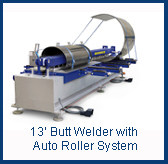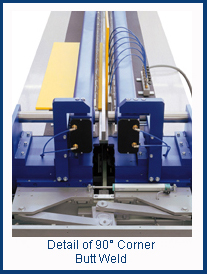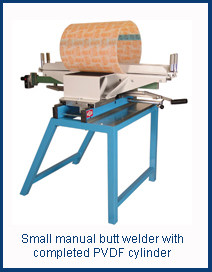|
Themoplastic Sheet Butt Fusion
Butt fusion, also referred to as heated element
welding or heated element butt welding, is a
widely used technology. The fusion
method is used in high volume production
applications of molded parts as well
as in the field of thermoplastic piping
and sheet products. The butt fusion
method generally provides a very
high quality weld when the material’s
 specific parameters are adhered
to. In principle, the process
requires that the materials to be
welded are held against a heated
plate, the heated plate is removed
and the materials are pressed together. The parameters
that need to be observed are time, temperature and
pressure. These vary depending on type
of material and size of weld surface. A
graph (Figure 1) explains the process as
follows:
specific parameters are adhered
to. In principle, the process
requires that the materials to be
welded are held against a heated
plate, the heated plate is removed
and the materials are pressed together. The parameters
that need to be observed are time, temperature and
pressure. These vary depending on type
of material and size of weld surface. A
graph (Figure 1) explains the process as
follows:
- The high pressure melting cycle
assures that a bead is formed all along
the heater plate to guarantee material
contact to the element.
- The low pressure heating cycle permits
the heat to be absorbed into the material.
- The change over time, i.e. the time it
takes for the element to be removed
and to bring the two materials into
contact with each other, needs to be kept to a minimum to
avoid cooling or even oxidation of the surfaces to be welded.
- The welding time allows the material to cool down
under pressure to form the appropriate molecular
bond. An important step here is the “Pressure built-up
time,” which should be performed as a ramp, rather
than smashing the materials together and squeezing
the heated molecules out of the weld zone.
Machine Requirements
The German Welding Society (DVS) has comprehensive
guidelines for this process and materials and DVS 2208-
1, in particular, spells out in detail the requirements for
butt welding machines for both piping and sheet. A few of
these cover: -
Machine frame, construction and guide/travel elements.
- Material clamping fixtures and their impact on machine
base.
- Machine table travel parallelism and table top alignment.
- Heating element positioning, temperature accuracy and
surface condition.
- Machine controls
Most larger machines today are equipped with full CNC
controls and can be optimized to include force or table
travel monitoring, data logging and recording of all welds
for quality assurance and tracking purposes. Machine precision
in construction and functionality are prerequisites
for the quality of the welds as well as durability and
longevity of the machine itself.
Operator Expertise
While CNC controlled machines facilitate the task of the
operating personnel by calculating the machine settings
based on material type and overall surface to be welded,
operators need to pay attention to some principles to
assure good welds. These include: -
Welding Surfaces: All welding surfaces need to be
clean, especially when welding sheet, as sheet butt
fusion machines do not incorporate surface preparation
which is performed with the facing/planning
operation in pipe welding.
- Condition of Heating Element: Element surfaces should
have clean, anti-stick coating, free of residue and easily
release hot melt. Elements should be cleaned and
recoated when necessary. Residue on the element can
contaminate the weld zone and lead to weld failure.
- Verification of Welding Parameters: When changing
parameters, welds should be tested and validated. It is
also good practice to validate welds with newly received
sheet lots.
Benefits of Butt Welding
The benefits of butt
welding versus manual
processes such as extrusion
or hot air welding are
multifold. The process is
 faster and less dependent
on operator expertise and
attention for every inch of
weld, it is fully repeatable
and the welding parameters
are much more precise.
Manual processes
further require a welding
rod, introducing a secondary
material into the weld
zone and using hot air which causes higher stresses.
Combined with process accuracy, the butt welding technology
produces weld qualities which allow butt welded
materials to be used as regular sheet.
faster and less dependent
on operator expertise and
attention for every inch of
weld, it is fully repeatable
and the welding parameters
are much more precise.
Manual processes
further require a welding
rod, introducing a secondary
material into the weld
zone and using hot air which causes higher stresses.
Combined with process accuracy, the butt welding technology
produces weld qualities which allow butt welded
materials to be used as regular sheet.
Applications
In sheet fabrication, butt welding
is performed to obtain
larger sheet, to easily fabricate
cylindrical structures,
to recover scrap
and, with 90º welding  technology, to efficiently make
corners for U channels or
tanks. Today’s applications
not only include PP, PE
and PVC/CPVC as well as
PVDF materials but customized
specialty butt
welders are available
for UHMWPE, fluoropolymers,
various types
of olefin or vinyl foams of numerous densities and materials
with different geometries such as corrugated/ hollow
wall or anchor sheet.
technology, to efficiently make
corners for U channels or
tanks. Today’s applications
not only include PP, PE
and PVC/CPVC as well as
PVDF materials but customized
specialty butt
welders are available
for UHMWPE, fluoropolymers,
various types
of olefin or vinyl foams of numerous densities and materials
with different geometries such as corrugated/ hollow
wall or anchor sheet.
The wide range of standard and customized butt fusion
equipment available today allows companies in the thermoplastic
welding and fabricating industry to effectively
produce structures and fabrications in the sheet, piping
and molded parts markets to assure quality, gain efficiency
and pursue new markets to expand their business.
Written by Dagmar Ziegler, Vice President, Sales,
WEGENER Welding, LLC, distributors of thermoplastic
welding and fabrication equipment including hand welding
systems, extrusion welding systems, sheet bending
and fusion machines, pipe butt and socket fusion tools
and equipment, pipe band saws, AC and DC spark testers
and a wide variety of specialty welding equipment.
For more information, contact WEGENER Welding,
LLC, 16W231 S. Frontage Road, Suite 12, Burr Ridge, IL
60527, 630-789-0990, Fax: 630-789-1380, E-mail: info
@wegenerwelding.com, Web: www.wegnerwelding.com.
|